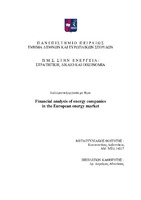Financial analysis of energy companies in the European energy market

Προβολή/
Λέξεις κλειδιά
Financial Analysis ; Energy market ; Energy companies ; Europe ; Energy policyΠερίληψη
The aim of this paper is the evaluation of the profitability, financial and liquidity performances subsequent to the reactions of the energy company management, following the market opening. This analysis is carried out taking into account the geographical position of the companies that significantly influence the strategic reactions of firms.
Europe, which is heavily dependent on oil and gas from external sources, has been engaged in a debate on building an integrated and competitive energy market since the early 1990s. Leaving aside the previous national energy models, the EU has instituted to share the responsibility to develop a strategic policy to change current trends. A truly competitive, single European electricity and gas market is expected to be a free market and open to competition of Europe-wide companies rather than being restricted to only dominant national actors. The new energy market will improve security supply and boost efficiency and competitiveness. According to a Green Paper, the energy strategy of the EU has three pillars which balance fundamental needs of the Union; securing an expanding supply of energy from both domestic and foreign sources, developing a more competitive internal energy market, and encouraging and supporting environmental protection and development of clean and renewable energy sources.
The market reform in Europe has started with the British experience and the developments in British markets inspired the EU energy strategy and became the main driver for further developments. Over recent years, a number of changes have occurred in the European energy sector, but 10 years after the Lisbon Treaty the energy markets of Europe still are significantly far from the unique energy market goal. The theoretical framework of the European energy policy seems to be suitably designed, but its application is posing considerable problems.
European energy policy‐making has always been a balancing act between European and national competences; between government involvement and free markets; and between the public interests of security of supply, the environment and relatively low prices (recently translated into competitiveness). The implementation of policy measures that change the market structure is a delicate undertaking because each member state’s energy market is structured differently in terms of energy mix, import dependency and organization. Market saturation, resource nationalism and security of demand (security of investment) often mean that measures that are optimal according to textbook economics play out differently in the dynamic reality of market developments. The actual impact of policy measures on the strategic behavior of companies is often ignored, and policy outcomes are not as clear cut as theory suggests. The main competence of the EU is in the area of competition in the internal (European) market, leaving sufficient room for national interpretations regarding the structure of domestic markets. This room for interpretation is amplified by the national competence over security of supply issues, showing definite but distinctly different preferences among member states.
Moreover, EU environmental policies provide member states with tools to engineer national strategic environments for their companies that help −or hinder− them in their strategic approaches to the EU market. Companies are thus facing a complexity of national and EU market designs in which they must shape their strategies for certain member state markets and decide on their overall EU approach. Thus, both historical and regulatory differences among member states provide energy companies with different strategic toolsets with which to develop their EU strategies. Companies are not mere followers of the national and EU market design but are active participants in shaping this process. Generally, companies adapt their strategies to a changing environment, a process that often moves faster than the implementation of new policy measures. These strategic reactions are often taken to mitigate risks and to secure a strong position in an increasingly competitive market. Such responses interact with the main policy priorities. It is therefore interesting to understand the interaction between company strategies and policy priorities and to assess whether synergies can be found and whether strategies and policy objectives can be aligned.
The structure of the paper is as follows. Chapter 2 introduces the major changes that have taken place and that have formed the basis of the EU’s Energy Market. Chapter 3 presents the key changes that happened in Europe's energy mix in 2017. Chapter 4 discusses the alignment of company strategies and policy objectives and presents a number of recommendations to make use of the companies for reaching policy and financial targets. Chapter 5 presents the chosen figures to be calculated, the method of calculation and the results of each indicator for the sample of the energy companies. The tables on which the calculation of the ratios and the tables were based, in the results of which the charts were based, are also presented in the fifth chapter. The final chapter provides the conclusion.


